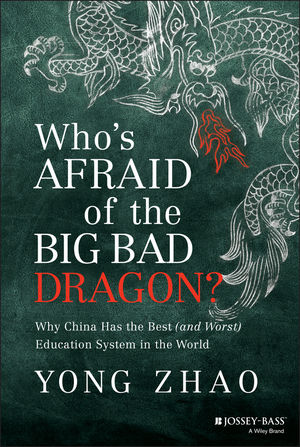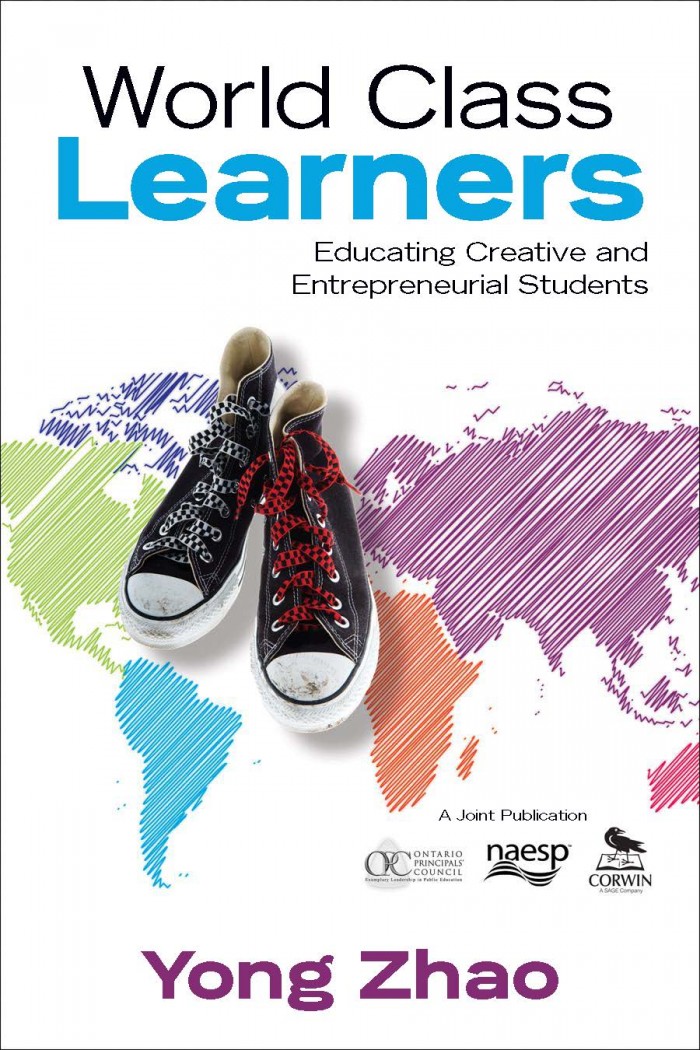Does the U.S. Want what China Wants to Throw Away: The Role of Testing in Two National Education Reform Plans
In front of me are two documents that could significantly affect the future of the world. I am not exaggerating because these two documents are plans to overhaul education in two of the most powerful nations in the world: China and the United States. If the plans are executed as intended and outcomes achieved as expected, the future will see China moving closer to being a center of innovation and the US? – a nation of test-takers, like China today.
China released the second draft of Guidelines for Mid and Long-Range Education Reform and Development Plan (2010-2020) at the end of February, 2010 to solicit public comments. A couple of weeks later, the United States released A Blueprint for Reform: The Reauthorization of the Elementary and Secondary Education Act, which also uses 2020 as the target year.
While both plans are a continuation of reform efforts that had been undergoing for a while, they propose some thing much more serious for the next round. In other words, the two plans now are pushing exactly the “right button” to generate systemic and long lasting changes.
The “button” is the criteria and means to judge the quality of education. Every society uses some way to measure the quality of education its schools and teachers provide and reward or punish them with tangible (e.g., money) and or intangible (e.g., recognition) consequences. What and how education is measured often drive educational practices in schools and classrooms, which in turn affect the ultimate outcome of education: the qualities of talents a society gets.
In China, gaokao, or the College Entrance Exam, has been used as a primary indicator of the quality of education for several decades. Although it takes place only at the end of basic education, it drives educational practices from kindergarten on. Technically the gaokao assesses only individual students and does not explicitly or directly assess teachers and schools, but because it practically determines whether a student can get into college and then a better life, it is the summative evaluation of schools. In other words, how well schools and teachers prepare their students to take the gaokao has been accepted as the primary indicator of the quality of education they provide.
Therefore, in China, high schools are judged based on the proportion of their students admitted to colleges. High schools with more students doing well on the gaokao are considered better schools and are rewarded with more funds, better reputation, and attract more students. Their principals and teachers are considered celebrities and better compensated. Similarly, middle schools that have more graduates moving into these high schools are considered better, and elementary schools that send more students into better middle schools are viewed as better schools.
Thus, although China never had a national education quality assessment program, the gaokao has been the de facto measure of educational quality. Since the education system revolves around getting good scores on the gaokao, the Chinese government has termed its education systems “test-oriented,” a system viewed incompatible with China’s determination to transform into an innovation-based economy because the “test-oriented” education results in citizens who maybe good test takers, but nothing else. In addition, the gaokao only tests knowledge in a few subjects (primarily math, Chinese language, and English, plus some other subjects depending on which province one resides in), it seriously discriminates against students with abilities and talents outside these tested subjects, who have little chance of success in their education career.
To fulfill its desire to become an “innovation-based” economy, China needs a diversity of creative and innovative talents.
China has fully recognized the damages of the gaokao and has been working on curriculum and pedagogical reforms in order to mitigate the negative consequences of gaokao. It has also been trying to reform the gaokao. But until now it has not touched the root cause on a national scale (for more discussion about education reforms in China and the problems of gaokao, pls. read my recent book Catching Up or Leading the Way: American Education in the Age of Globalization).
In this new reform plan, China seems be much more determined to make significant changes to the gaokao in a number of ways. First, grant universities more autonomy in deciding how they wish to admit students, thus possibly diversifying admissions criteria and procedure. Second, allow students to take the gaokao multiple times and turn it into more like the SAT or ACT. Third, make scores on the gaokao only one of the elements in admissions decisions. Fourth, encourage schools to recommend students with special talents to universities. These measures have been piloted in China on smaller scale in different provinces. The plan is to implement them across the system.
To further reduce the negative impact of gaokao, the plan specifically forbids the use of percentage of graduates admitted to colleges to evaluate teachers and schools by local authorities.
In contrast, the Blueprint for the reauthorization of ESEA in the U.S. pushes to another extreme. Despite all the language about innovation and flexibility, the true leverage the federal government wishes to use is test scores in a few subjects on a national scale. “Common standards” in math and language arts are to become a mandate for all states. To implement these standards, common assessment is called for. One can well expect that once common assessments in these two subjects are in place, schools and teachers will be evaluated based on their students’ performance on these tests. Then accountability measures follow. Soon, the US will have a system like China’s gaokao.
The gaokao has not produced citizens China wants in the 21st century. I doubt it will do wonders for the United States.




























Have you seen what they are doing at Shantou University in regards to credit reporting systems and the impact it would have on how gaokao is used? Look at the Cheung Kong School of Communications and Media for some insight into this. If you can gain little from the website, then please email me, and I am happy to introduce you to some key people there.
In management circles, it is deemed axiomatic: you get what you measure. If you measure performance on standardized-tests, then you get citizens who do well on such tests.
Education is never taken seriously. It is usually left to fashions and fads, and so swings wildly like a pendulum in many countries.
EthicMinds
george
thanks for your analysis.
Yong:
Keep in mind that the tests in the US are no-brainers for any student who is hard working and/or bright. They won’t do any real harm as far as the innovative class is concerned. I agree that the US is on the wrong track, but they are going so slowly on this track that it won’t hurt the country’s productivity in its current form. Thanks to efforts like yours, we are likely to get off this track before any real train wrecks happen. The other key point is that US schools are so hard to change that any misguided efforts won’t have much impact. If you are not familiar with the work for Rogers on the Diffusion of Innovations, let me know. Keep up the good work.
Best,
Douglas W. Green, EdD
DrDougGreen.Com
Dr. Zhao’s concerns are extremely valid, but Mr. Green’s observation about how hard it is to effect any type of change in Education is also realistic. Nevertheless, the push for national standards and testing should give us all cause for concern.
In my work with school districts and in my former position as Assistant Superintendent for Educational Services, I developed a real concern about this test-score-mania that has taken root in the Educational system. When I work with school districts now, I hear about lots of strategies, programs, techniques and materials that are aimed at “bubble kids” or “strategic kids” or “kids in the basic group.” In other words, I hear districts talk about how they can address the needs of some “high value” kids (kids whose test scores have greater impacts on the school’s overall test scores) and improve their overall test scores.
These discussions are tragic! They do not align with our American ideals on equity, and they are counter-productive to improving overall achievement.
What I do not hear in these school districts is: “How can we improve the overall educational program?” or, “What can be done better to help all students achieve more?” or, “What can be done to address the underlying causes of low academic achievement?” and, worst of all, “How can we better measure our success with children?”
To think about this metaphorically: There have been many baseball seasons where the team with the best record (test scores) did not go on to win or even participate in the World Series (real life). If we go on with this current push toward standards and improving test scores, we will produce learners whose high test scores entitle them to be spectators at the World Series while the enlightened nations of the world (including China) participate in it.
[…] not convinced that national standards are the answer. They may, in fact, be more of a problem (as Yong Zhao notes in his blog). My bigger concern is the role that ACT and Achieve, Inc have played in the crafting of these […]
I agree with Dr. Zhao’s assessment. I am with Dr. Zhao in the immediacy of the need to change and get away from this twisted view of how test scores judge a student and an educator. Yes, we need ways to measure progress, but nationalized testing is not the way. Dr. Zhao states his case against standardized tests very well in his book Catching Up or Leading the Way. I hire the product of our education system. I create highly innovative software. I see problems in most of the new hires and interns – they don’t cut it. In education we spend so much time chasing a test score that we forget that after school is done and the student has regurgitated their last time at the alter of the standardized test. They must then go and become successful in a world that wants them to be creative, innovative, productive and does not value being highly proficient at performing on a test – that is unless they go to work in education. As I talk to business leaders they all feel that standardized testing is a waste of time, yet somehow we keep rolling towards that goal. While other countries fly away with singed wings we are a moth heading right to the flame ignoring the bigger picture and focused on the fire that is the national test.
Not wanting to be a conspiracy type here – but if the majority sees something wrong, and our politicians are pushing us towards this goal – then who makes all the money that makes it worth doing the wrong thing?
Mr. Green and Mr. Loesch – I hope that you are wrong about how slow it will be for us to get off this path.
Re: Mr. Waddell’s not wanting to be a conspiracy type. I’ve felt the same way for some time–why do we continue down the wrong path? Why are our leaders doing this to our kids and our country? I conducted research on school reform in Sweden hoping to inform U.S. schools. What I found were highly progressive, learner-centered practices, and students who were relatively motivated and happy–didn’t have the demeanor of a prisoner as our U.S. students too often have. And, I should add, far advanced academically compared to my students in Florida. There were many cultural and political reasons for the success of the Swedish 1994 national school reforms, but I felt many of these could be replicated in the U.S. Much to my dismay, Sweden started instituting a U.S.-type system based on testing a few years ago, coinciding with a political change in Stockholm. My Swedish educator friends are desperately hoping the September elections will bring back some sanity. But then again, I thought the 2008 elections would do the same for the U.S. education system. We know how that turned out…I got my first inkling of what was to come when I heard Arne Duncan speak on a panel at an October 2008 conference. I thought I was listening to Margaret Spellings or Rod Paige. So how do we get the ears of the policy makers? Why does business with so much clout in Washington and the statehouses not influence change? All surveys indicate that they understand the fallacies of our test-centered system. Will it take China to lead the way? If there are pockets of change (fostering creativity and other 21st Century soft skills) in China, please let me know where they are. I’m itching to get there to find out how they are doing this.
Hello Dr. Zhao,
How do you think the education equity, which Premier Wen emphasized much, of Chinese education system?
Re: R.D. Nordgren why we are continuing down the wrong path: the only explanation that seems reasonable to me as to why people would knowingly continue down a seemingly wrong path is that there MUST be some personal gain to be gleened from doing so. It’s a sad commentary on our educational system (of which I am a part, as an educator), but I fear it is true. I can’t produce hard evidence for this conclusion, but my mind cannot wrap itself around an alternative. Maybe it’s the politicians themsleves, maybe the unions, maybe the testing agencies … somebody gains from our students and teachers being subjected to, and governed by, these high stakes tests.
Feel free to comment:
The views expressed on this site are entirely my own. They do not represent my employer or any other organization/institution. All comments are subject to approval.Archive
03.17.24 Focused: Understanding, Negotiating, and Maximizing Your Influence as a School Leader
02.25.24 What Happened to Global Competence?
08.05.23 Rethinking the time spent at school: Could flexibility improve engagement and performance for students and teachers?
01.17.23 Introduction to Improbable Probabilities: The Unlikely Journey of Yong Zhao
01.05.23 How Not to Kill Creativity?
08.19.22 Preface to Improbable Probabilities: The Unlikely Journey of Yong Zhao
02.05.22 Introduction to New Book: Learning for Uncertainty: Teaching Students How to Thrive in a Rapidly Evolving World
09.25.21 Side effects in education: Taxonomy of educational outcomes
07.13.21 Introduction to My New Book: Learners without Borders
03.09.21 New article: Build back better: Avoid the learning loss trap
02.18.21 New article: The changes we need: Education post COVID-19
09.15.20 Watch Ep4 Creativity in Crisis: How well is creativity understood? A Conversation with Barb Kerr, Haiying Long, Ron Beghetto, & Yong Zhao
08.15.20 Can Creativity be Taught? Ep 3 of Creativity in Crisis on August 28th 3:00-4:00pm Pacific Time
07.13.20 Speak a Different Language: Reimagine the Grammar of Schooling
06.11.20 Assessing Creativity in the Classroom? Recording of Ep2 of Creativity in Crisis
Tag Cloud
Accountability achievement gap CCSSO China/Chinese Commissioner Common Core Standards education Educational Policy Education Reforms national standards New York NGA Singapore standardized testing Standards student performance
WP Cumulus Flash tag cloud by Roy Tanck and Luke Morton requires Flash Player 9 or better.
Silverliningforlearning
Most Commented
Most Viewed
Views expressed on this site are entirely personal. They do not necessarily represent the official positions or views of my employer
Powered by WordPress | Log in | Entries (RSS) | Comments (RSS) | Arthemia theme by Michael Hutagalung